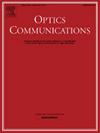基于卷积神经网络抑制波长调制光谱学中的干涉条纹
IF 2.2
3区 物理与天体物理
Q2 OPTICS
引用次数: 0
摘要
为了减轻波长调制光谱(WMS)中的干涉条纹,我们引入了一种基于卷积神经网络的新型滤波器(New CNNF)。这种滤波器能有效抑制干扰条纹的高频和低频变化,包括那些带包络线的干扰条纹。为了在整个频谱范围内全面抑制干涉条纹,同时适应不同的腔长条件,我们面临着数据稀疏性的挑战。为此,我们引入了一种开创性的方法:通过浓度柱密度归一化对数据集进行精细分割,从而实现显著的降噪。通过新型卷积神经网络过滤器(New CNNF)的处理,样本的信噪比(SNR)从原来的-10.11 dB提高了26.70 dB。当蚀刻管长度为 2 厘米和 100 厘米时,新 CNNF 预测的二次谐波信号振幅与相应标签浓度的拟合度分别达到 0.9995 和 0.9999。实验结果表明,新 CNNF 有效抑制了 TDLAS-WMS 系统中的高低频变化和包络干涉条纹,从而提高了甲烷浓度测量的准确性和稳定性。我们选择了 λ = 1.654 μm 处的 CH4 转变来验证这种方法。我们的方法显示出广阔的应用前景,并可扩展到其他气体分子的传感。本文章由计算机程序翻译,如有差异,请以英文原文为准。
Suppression of interference fringes in wavelength modulation spectroscopy based on convolutional neural networks
To mitigate interference fringes in wavelength modulated spectroscopy (WMS), we introduce a new filter based on convolutional neural networks (New CNNF). This filter effectively suppresses both high and low-frequency variations of interference fringes, including those with envelopes. In striving for comprehensive interference fringe suppression across the entire frequency spectrum, while accommodating diverse cavity length conditions, we confront the challenge of data sparsity. To address this, we introduce a pioneering methodology: finely segmenting the dataset through concentration column density normalization, thereby achieving notable noise reduction. Through the construction and training of the New CNNF model, it was found to exhibit superior performance compared to traditional filtering algorithms, particularly under low signal-to-noise ratio (SNR) conditions.
Following processing with the novel convolutional neural network filters (New CNNF), the sample's signal-to-noise ratio (SNR) improved by 26.70 dB, increasing from the original −10.11 dB. When the etalon lengths were 2 cm and 100 cm, the goodness of fit between the predicted second harmonic signal amplitude by New CNNF and the corresponding label concentration reached 0.9995 and 0.9999, respectively. Experimental results demonstrate that New CNNF effectively suppresses high and low-frequency variations and enveloped interference fringes in the TDLAS-WMS system, thereby enhancing the accuracy and stability of methane concentration measurements. CH4 transitions at λ = 1.654 μm were selected to validate this approach. Our method shows promising application prospects and can be extended to the sensing of other gas molecules.
求助全文
通过发布文献求助,成功后即可免费获取论文全文。
去求助
来源期刊

Optics Communications
物理-光学
CiteScore
5.10
自引率
8.30%
发文量
681
审稿时长
38 days
期刊介绍:
Optics Communications invites original and timely contributions containing new results in various fields of optics and photonics. The journal considers theoretical and experimental research in areas ranging from the fundamental properties of light to technological applications. Topics covered include classical and quantum optics, optical physics and light-matter interactions, lasers, imaging, guided-wave optics and optical information processing. Manuscripts should offer clear evidence of novelty and significance. Papers concentrating on mathematical and computational issues, with limited connection to optics, are not suitable for publication in the Journal. Similarly, small technical advances, or papers concerned only with engineering applications or issues of materials science fall outside the journal scope.
 求助内容:
求助内容: 应助结果提醒方式:
应助结果提醒方式:


